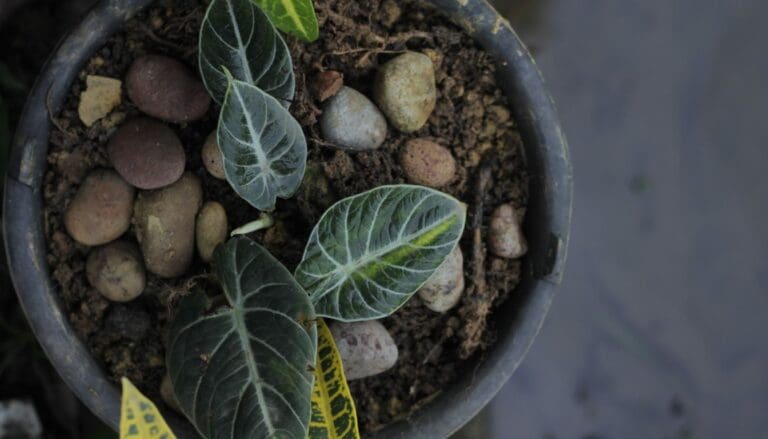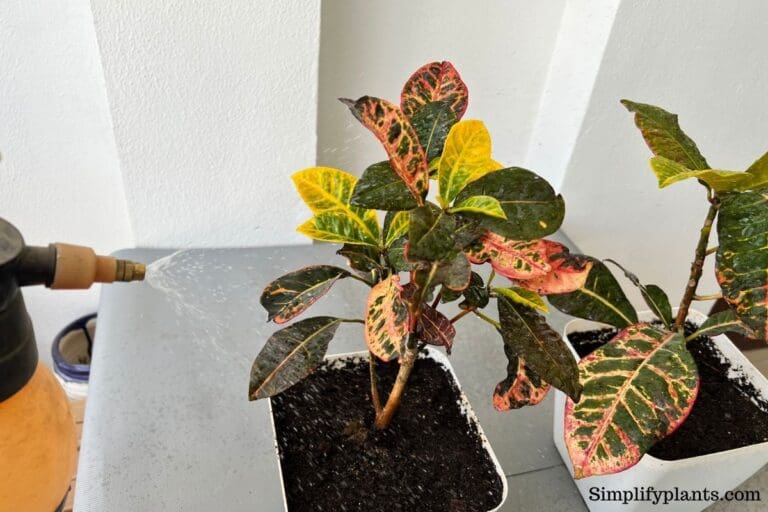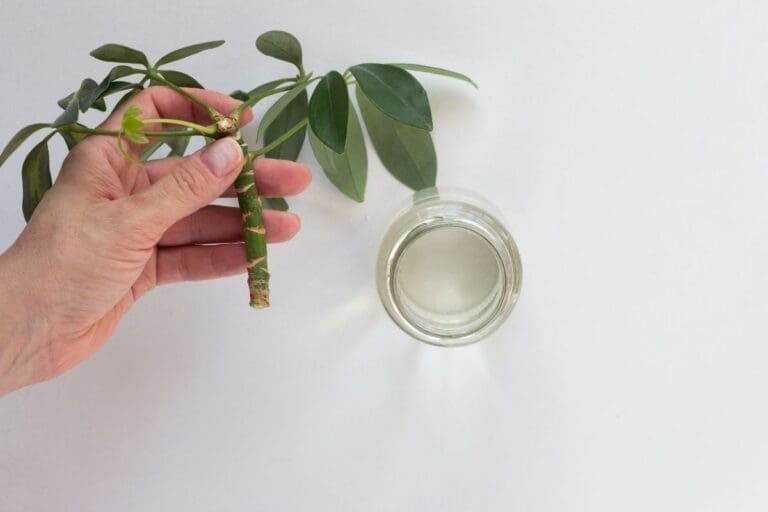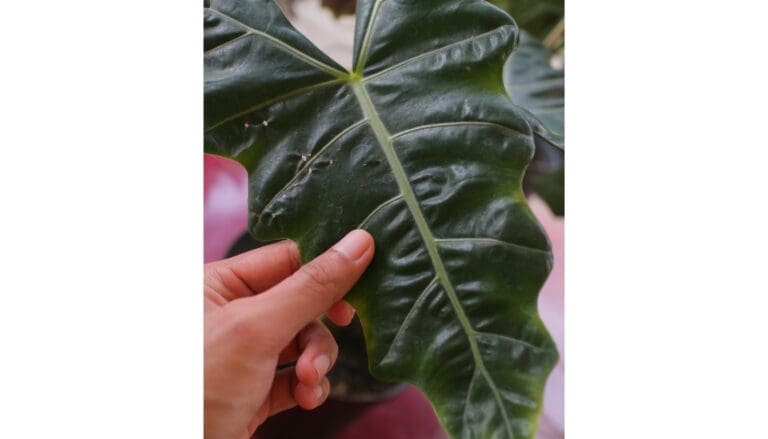How Much Should I Water My Chinese Evergreen? (How Often+Summer & Winter)
Chinese Evergreen or Aglaonema is a beginner-friendly houseplant that requires low maintenance. It’s a great plant to start your indoor gardening journey with. But watering the houseplants is a confusing aspect where people make the most mistakes.
Let’s find out how much water does a Chinese Evergreen needs.
Chinese Evergreens require water once a week during the spring and summer and once in two weeks during the winters. Since this plant prefers slightly moist soil, you should not let the soil go completely dry before watering. But, you must always check the soil before watering.
Although I gave you a general idea, other factors can determine or alter the water requirements of your Chinese Evergreen plant. I have covered all those information in this article, so keep reading.

Please note: Simplify Plants is reader-supported. Some links in the post are affiliate links and I get a commission from purchases made through links in the post.
Chinese Evergreen Water Requirements
The season is the most crucial factor you need to consider while watering your Chinese Evergreen. You can’t give it the same amount of water throughout the year.
Summer
Summer and Spring are the warmer seasons of the year, and this is when your Chinese Evergreen grows the most. This is why these two seasons are referred to as the growing season.
During the growing season, the sun shines bright in the sky, and the plant absorbs the indirect rays of the sun and functions at its best. The water you give the plant is used up fast, and the soil dries fast due to the sun.
As soon as the soil starts drying and the top 2-3 layers dry out, the plant requires water. This takes around 7-10 days. So you need to water your Chinese Evergreen once a week or once in 10 days during the growing season.
Don’t water the Chinese Evergreen without checking the soil’s moisture level and just by blindly following a routine.
Winter
Winter is the coldest time, not ideal for most houseplants, including Chinese Evergreen. Naturally, plants become dormant during this time.
The low temperatures, low humidity, less intense sunlight, and shorter days make it difficult for the houseplants to grow. So, they go into a period of rest where they conserve their energy and try to survive.
During this time, the activities of the plant remain less, and the soil takes time to dry out. Therefore, the plant requires less amount of water at longer intervals.
On average, a Chinese Evergreen will require water once in two weeks during winter but don’t water without checking the moisture.
During winter, the water temperature might go down, so remember that cold water can shock the plant. Water your Chinese Evergreen with room temperature water only.
How do you know if Chinese Evergreen needs water?

There are different ways to figure whether your Chinese Evergreen needs water or not. I will discuss the ones I have used to understand if my plant requires water.
Finger: The easiest way is to put your finger inside the soil. Make sure you stick the finger 2-3 inches deep to understand if the soil is wet. If the soil sticks to the finger, it still has water, and you must wait. But if the soil feels dry and doesn’t stick, you can water your Chinese Evergreen.
Moisture meter: The next best thing is a moisture meter, especially for those who don’t want to get their hands dirty. This is also an efficient way of checking the soil’s moistness. You just need to insert the moisture meter into the soil, and if the reading on it is 2 or 3, you can water the plant.
Touch the pot: If your Chinese Evergreen is sitting in a clay or terracotta pot, you can touch the pot and find out if it needs water. The pot will feel wet when you touch the sides, or the bottom of the soil is moist.
Look at the pot: In the case of clay or terracotta pots, you can determine the water requirement even by looking at the pot. If the soil is moist, the pot will appear dark, while if the soil is dry, the pot will have a lighter shade.
Lift the pot: Another easy way of understanding the water needs of your Chinese Evergreen is by lifting the pot. If the pot feels heavy, your Chinese Evergreen will not require water, but you can water the plant if the pot feels light.
Does Chinese evergreen need a lot of water?
Chinese Evergreen never needs a lot of water. They do well with a moderate amount of water.
Chinese Evergreens enjoy slightly moist soil at all times. So you should water it enough to keep the soil moist and not let it go dry entirely.
However, you should also not water too much that makes the soil waterlogged. The plant will not enjoy sitting in wet soil, leading to root rot.
How much water a Chinese Evergreen will need can depend on a few factors such as:
- Temperature
- Humidity
- Light
- Soil
- Pot
Let’s understand how these factors affect the water requirements of the plant.
Temperature: The temperature varies as per the season. When the temperatures remain high, the soil dries up faster, and hence the plant will require frequent watering.
In contrast, when the temperatures start going low, the soil starts taking longer to dry, requiring less water.
Humidity: Chinese Evergreen plants love high humidity. And if it gets high humidity, it will not require a lot of water. You can use a humidifier to maintain the humidity that a Chinese Evergreen requires.
If the plant is not getting enough humidity, you should mist it and water it when the topsoil dries.
Light: Plants require light to produce energy and food. If the light levels are high, the plant will remain active and perform all its daily activities, and the water will get used up fast, due to which the water requirement will be high.
But if the plant doesn’t get enough light, you need to water it less. Otherwise, it will get overwatered.
Soil: Chinese Evergreen prefers a well-drained soil mix that can drain excess water fast. Such soil will dry up on time and require more water.
But a soil that takes time to get dry will require less water. This will, however, not be ideal for the Chinese Evergreen plants.
A peat-based soil will perlite will be suitable for the Chinese Evergreen. You need to ensure that the potting mix retains enough water and drains the excess.
Pot: Even the pot can affect the water requirement of your Chinese Evergreen. If you have placed it in a plastic pot, it will require less water as plastic is non-porous, and it doesn’t allow the soil to dry up fast.
But if the plant is in a clay or terracotta pot, the water will drain out fast, and the plant will require more water.
You should also consider the pot size. If the pot is big, it will hold more water and take time to dry. So in a bigger pot, the Chinese Evergreen will require less water.
The soil will hold less water in a smaller pot that will get used up fast and require frequent watering.
What happens when you overwater your Chinese Evergreen?

Chinese Evergreen plants prefer slightly moist soil, but they will not enjoy soggy soil. When you water without checking the soil’s moisture, you end up overwatering the plant.
Overwatering is a common problem that beginners make, but one can save the plant by acting fast. If not, the condition can get severe.
Here are some common signs of an overwatered Chinese Evergreen plant.
- Yellow leaves: A common sign of overwatering is that the lower leaves turn yellow. You can remove these leaves by pruning them from the base, or you can wait for them to dry out and fall off.
- Droopy leaves: Overwatering puts a lot of stress on the plant, and the roots fail to absorb nutrients from the soil and send it back to all parts. So, the leaves become weak and start drooping.
- Weak stems: Overwatering affects not only the leaves but also the stems. Due to lack of nutrients, the stems become weak, turning soft due to standing in water.
- Fungus growth: Overwatering can often lead to fungus or mold growth on the soil, and you must scrape the soil or change it entirely to get rid of it.
- Pest infestation: Most pests like aphids and mealybugs will attack an overwatered Chinese Evergreen and suck the sap, weakening the plant further.
- Root rot: Root rot is a deadly fungus disease. Overwatering keeps the roots wet and cuts the oxygen supply, due to which they start decaying. If you don’t get rid of the affected roots and repot the plant in fresh potting soil, the plant can even die.
How to prevent overwatering your Chinese Evergreen?
If you don’t want to cause the above problems to the plant, keep these tips in mind while watering.
- Don’t follow a watering routine blindly.
- Never water your Chinese Evergreen without checking the soil.
- Reduce the watering frequency and amount during winter.
- Provide enough light for the soil to dry up fast.
- Use a well-draining soil mix that can drain the excess water out of the system.
- The pot should have working drainage holes.
What happens when you underwater your Chinese Evergreen?

Since Chinese Evergreen prefers slightly moist soil, not giving it enough water will also cause some problems to the plant.
Although treating underwatering is much easier than treating an overwatered plant, you should still try not to keep your Chinese Evergreen thirsty for too long.
Here’s what you’ll notice on an underwatered Chinese Evergreen:
- Brown leaves: Without enough water, the leaves start getting discolored and turn brown. These leaves don’t become healthy even after you water the plant, so you need to get rid of them.
- Wilting leaves: When the plant doesn’t get sufficient water, the leaves start wilting to save whatever water is there in the leaves.
- Dry soil: If you keep your Chinese Evergreen thirsty, the plant will end up with dry soil, leading to other issues.
- Crispy foliage: The leaves lose their texture and turn dry and crisp without water. These leaves eventually fall off the plant.
- Slow growth: Without water, the plant will not have the energy to perform its regular activities, and hence you’ll notice slow growth.
How to prevent underwatering your Chinese Evergreen?
Reviving an underwatered plant is not difficult but preventing it in the first place is a better idea.
- Use a calendar to remind you that your plant needs water.
- Check the soil and water if the topsoil is dry. Don’t wait for the soil to go bone dry.
- If the plant is living in the ideal growing conditions, such as a warm climate with enough indirect sunlight, it will require water more often.
- Make sure that the soil retains enough water to remain moist.
How do you water Chinese Evergreens?
Avoid watering the leaves when you water your Chinese Evergreen.
Pour water into the watering can. Avoid using cold or hot water, and don’t opt for regular tap water as it contains harmful minerals such as bicarbonates, chlorine, fluorine, etc.
Now pour water into the soil and water it thoroughly. Wait for the excess water to start draining out of the drainage holes.
Allow the top 3 inches of the soil to dry out before watering the plant again.
Should I mist my Chinese evergreen?
If your Chinese Evergreen doesn’t get enough humidity, you can mist the plant. These plants prefer high humidity, so misting them will be a good idea.
You can even clean the leaves with a cloth after you mist them. Avoid misting the soil and mist only the leaves.
Final words

Chinese Evergreen is a tolerant plant that can forgive you for all your mistakes if you can identify the problem on time. However, it would be better to learn the plant’s requirements instead of making a mistake.
Water your Chinese Evergreen when the top 3 inches of the soil go dry. Don’t keep the plant thirsty for too long, as that will make the soil go completely dry. Also, avoid overwatering as soggy soil can cause root rot.
Reference: Wikipedia, Nasa clean air study, Missouri Botanical Garden, The University of Kansas, NC State University.
Recommended Garden Supplies
| Product Image | Our Recommended Gardening Supplies | Check Offers! |
|---|---|---|
Top Top
Top
Top
Top
Top
Top
Top
Top | rePotme Houseplant and Tropical Classic Potting Soil Mix | Check Offer On Amazon |
 Top
Top
Top
Top
Top
Top
Top
Top | Espoma Organic Indoor Plant Food | Check Offer On Amazon |
 Top
Top
Top
Top
Top
Top
Top
Top | GooingTop LED Grow Light 6000K Full Spectrum Clip Plant Growing Lamp | Check Offer On Amazon |
 Top
Top
Top
Top
Top
Top
Top
Top | Soil Moisture Meter | Check Offer On Amazon |
 Top
Top
Top
Top
Top
Top
Top
Top | Govee Hygrometer Thermometer, Bluetooth Enabled! | Check Offer On Amazon |
 Top
Top | LEVOIT Humidifiers for Large Room(Best For Plants) | Check Offer On Amazon |
 Top
Top
Top
Top
Top
Top
Top
Top | Upgraded DIY Automatic Drip Irrigation Kit, 15 Potted Houseplants Support | Check Offer On Amazon |
 Top
Top
Top
Top
Top
Top
Top
Top | Stainless Steel Heavy Duty Gardening Tool Set | Check Offer On Amazon |
 Top
Top
Top
Top
Top
Top
Top
Top | Bonide Insecticidal Soap | Check Offer On Amazon |
 Top
Top
Top
Top
Top
Top
Top
Top | Bonide 32 oz Spray Neem Oil for Organic Gardening | Check Offer On Amazon |
 Top
Top
Top
Top
Top
Top
Top
Top | Garden Safe Fungicide | Check Offer On Amazon |






